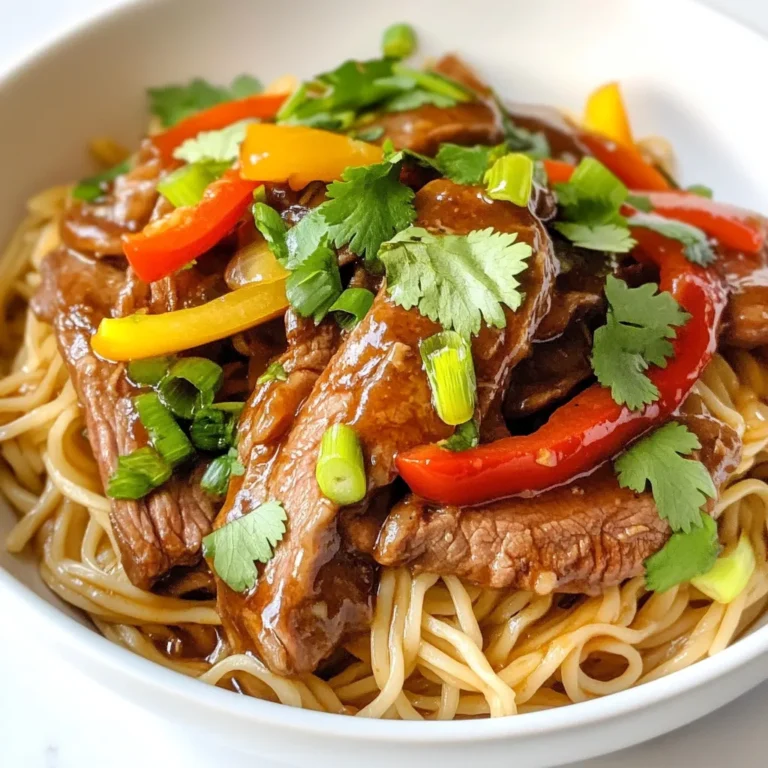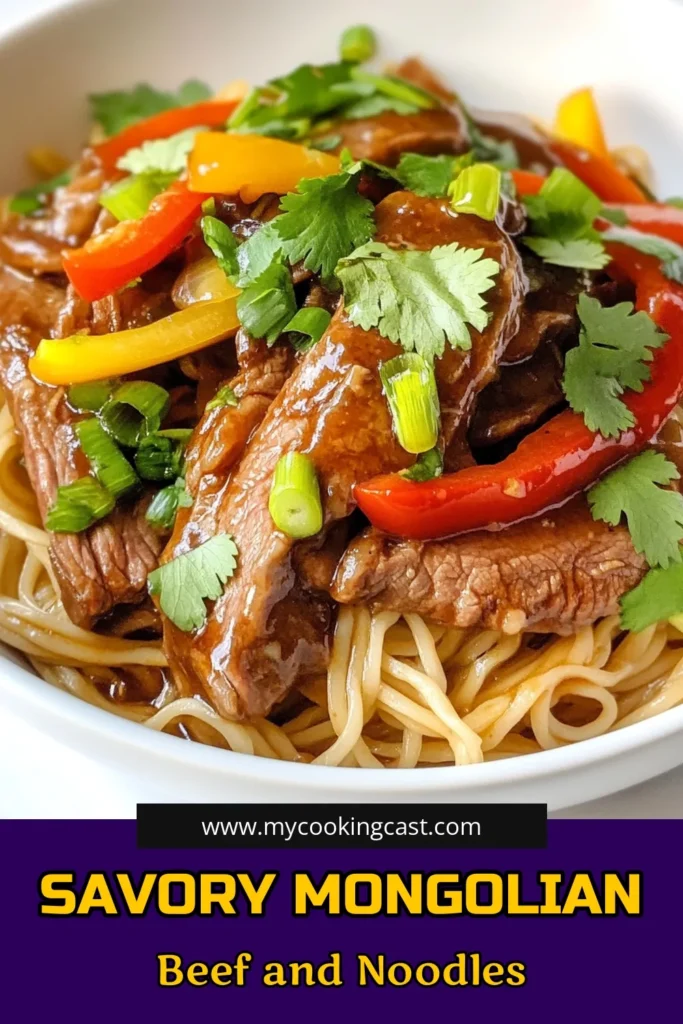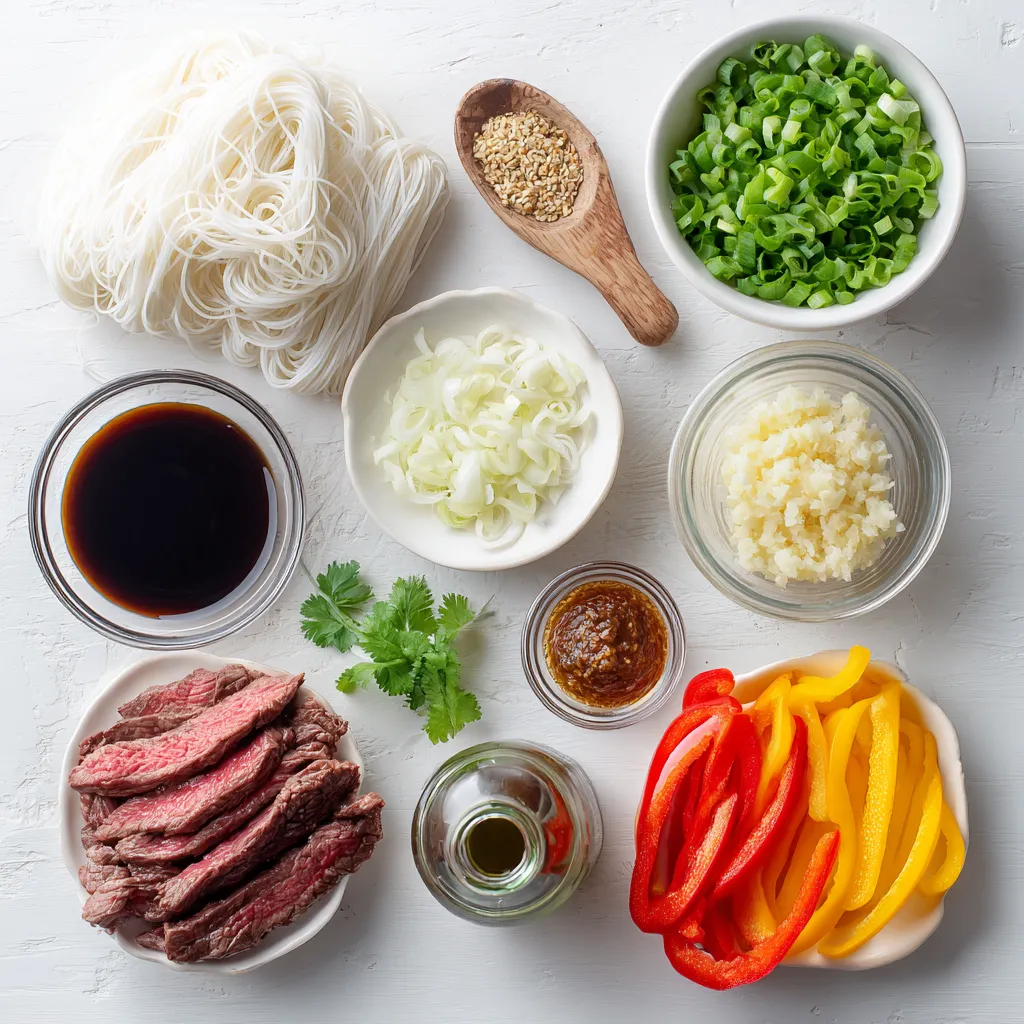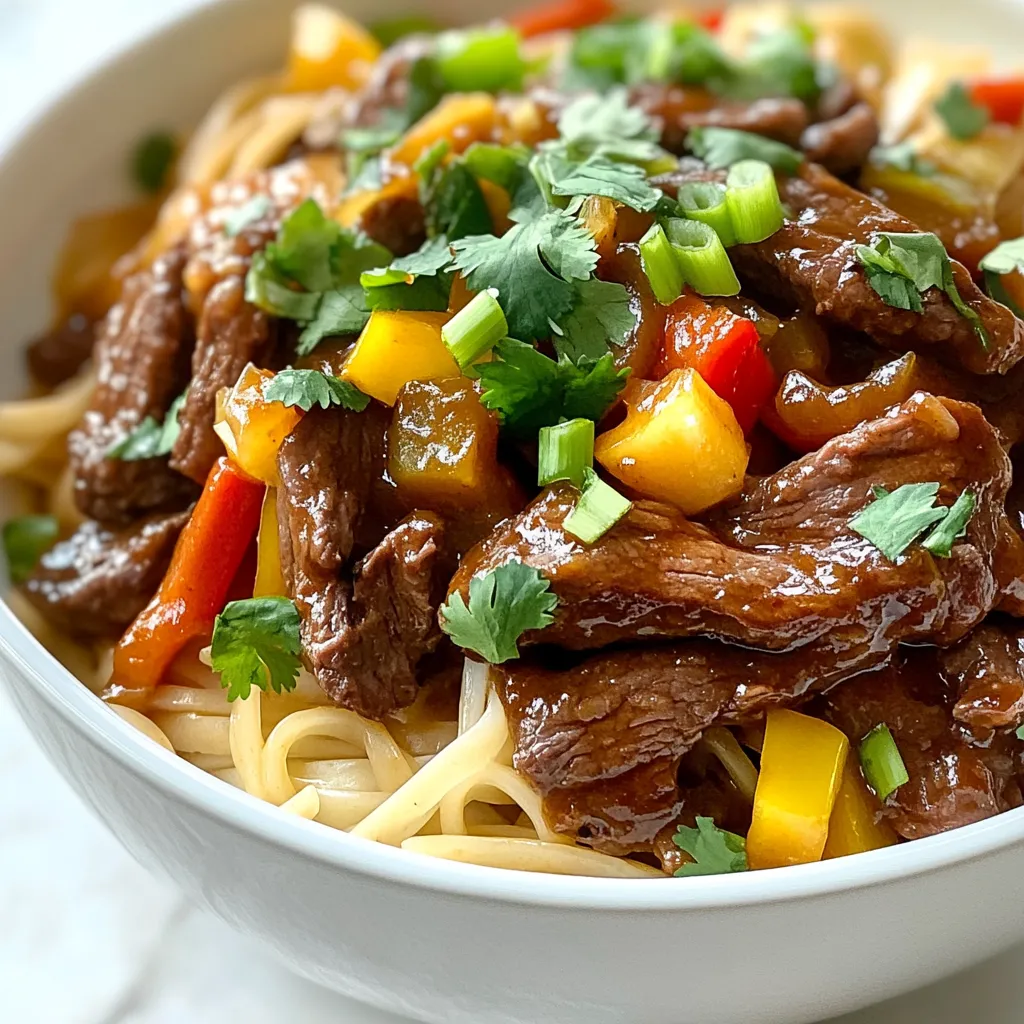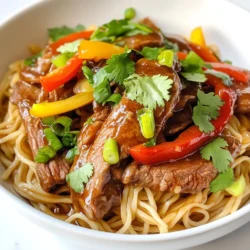WANT TO SAVE THIS RECIPE?
Are you ready to savor a dish that combines rich flavors and simple steps? In this post, I’ll share my easy recipe for Mongolian Beef Noodles that will impress your friends and family. With tender flank steak, rice noodles, and a blend of tasty sauces, you’ll whip up a delightful meal in no time. Let’s dive into all you need to create this flavorful dish!
Why I Love This Recipe
- Quick and Easy: This dish comes together in just 40 minutes, making it perfect for weeknight dinners.
- Flavor Packed: The combination of soy sauce, ginger, and garlic creates a rich and satisfying flavor profile.
- Customizable: You can easily add or substitute vegetables according to your preference, like bell peppers or broccoli.
- Delicious Leftovers: The flavors deepen even more the next day, making for amazing leftovers that are just as tasty!
Ingredients
List of Essential Ingredients
– 8 oz. rice noodles
– 1 lb. flank steak, thinly sliced against the grain
– 2 tablespoons vegetable oil
– 3 cloves garlic, minced
– 1-inch piece ginger, grated
– 1/4 cup soy sauce
– 2 tablespoons brown sugar
– 1 tablespoon hoisin sauce
– 1 teaspoon sesame oil
– Salt and pepper to taste
To make Mongolian beef noodles, gather these key items. The rice noodles serve as the base. Flank steak brings rich flavor. The seasonings and sauces create a bold taste. You’ll need garlic, ginger, soy sauce, brown sugar, hoisin sauce, and sesame oil.
Optional Ingredients
– 1 bell pepper, sliced
– 1-2 green onions, sliced (for garnish)
– 1/2 cup chopped fresh cilantro (for garnish)
You can add bell pepper for extra crunch. Green onions and cilantro add freshness on top. These ingredients elevate the dish and give it more color.
Dietary Considerations
– Gluten-free options: Use gluten-free soy sauce and rice noodles.
– Vegetarian alternatives: Substitute beef with tofu or mushrooms.
If you need gluten-free options, swap regular soy sauce for gluten-free. For a vegetarian dish, tofu or mushrooms work well as a protein swap. These changes keep the dish tasty while meeting dietary needs.

Step-by-Step Instructions
Preparation of Noodles
To start, soak the rice noodles in warm water. Let them sit for about 20-30 minutes. This helps soften the noodles. Drain the noodles and set them aside for later.
Cooking the Beef
Next, we’ll cook the flank steak. Heat a large skillet or wok over medium-high heat. Add 2 tablespoons of vegetable oil. Once the oil is hot, add the thinly sliced flank steak. Make sure not to overcrowd the skillet. Sear the beef for about 2-3 minutes. You want it browned and cooked through. After that, remove the beef from the skillet and set it aside.
Combining Ingredients
Now, it’s time to add flavor. In the same skillet, add 3 cloves of minced garlic and 1-inch grated ginger. Stir-fry these for about 30 seconds until they smell great. If you like, toss in sliced bell pepper. Cook this for another 1-2 minutes until it’s tender.
Return the cooked beef to the skillet. Pour in the sauce mixture made of soy sauce, brown sugar, hoisin sauce, and sesame oil. Cook everything together for about 2-3 minutes. Stir well to coat the beef and bell pepper.
Now, add the drained rice noodles to the skillet. Toss everything to combine and heat through for about 2 minutes. Season with salt and pepper to taste. Finally, serve hot, garnished with sliced green onions and chopped fresh cilantro. Enjoy your meal!
Tips & Tricks
Cooking Tips
– Avoiding overcrowding the skillet: Cook the flank steak in batches. If you add too much meat at once, it will steam instead of sear. This can make the beef tough. Sear each batch for 2-3 minutes until browned.
– Perfecting the noodle texture: Soak the rice noodles in warm water for 20-30 minutes. This softens them before adding to the skillet. Drain them well to prevent excess water from making your dish soggy.
Sauce Customization
– Adjusting sweetness and saltiness: You can change the flavor of your sauce to fit your taste. If you prefer a sweeter dish, add more brown sugar. For a saltier kick, increase the soy sauce. Taste as you go to find the right balance.
Garnishing Ideas
– Best practices for presentation: Garnish with sliced green onions and chopped cilantro. This adds color and fresh flavor. A sprinkle of sesame seeds can also enhance the look. Serve your dish in a wide bowl for a beautiful display.
Pro Tips
- Slice Against the Grain: This ensures the flank steak remains tender and easy to chew. Cutting against the grain shortens the muscle fibers.
- Soaking Noodles: Soaking rice noodles in warm water helps them soften evenly. Avoid boiling them to prevent overcooking and sticking.
- High Heat for Searing: Cooking the beef at a high temperature allows for a nice sear, enhancing flavor while keeping the interior juicy.
- Add Fresh Herbs Last: Incorporating fresh cilantro and green onions at the end preserves their vibrant flavor and color, making the dish more appealing.

Variations
Different Meat Options
You can switch the beef for chicken or pork. Chicken breast works well. Slice it thinly like the beef. Use the same cooking methods. Pork also fits nicely. A pork tenderloin can add a new taste. Just remember to adjust cooking times as needed.
Vegetarian and Vegan Versions
For a meat-free dish, use plant-based proteins. Tofu is a great choice. Press it to remove water, then cut it into cubes. Tempeh is another option. It has a firmer texture and absorbs flavors well. You can also try seitan for a chewy bite.
Noodle Alternatives
Not a fan of rice noodles? You have options! Try egg noodles for a richer flavor. Soba noodles add a nutty taste and are healthy. If you’re looking for gluten-free, use zucchini noodles. They add freshness and a fun twist to the dish.
Storage Info
Refrigeration Instructions
To store leftovers, let the dish cool completely. Place the Mongolian beef noodles in an airtight container. Make sure to keep it in the fridge. This way, it stays fresh and tasty. Consume the leftovers within three days for the best flavor.
Freezing Guidelines
If you want to freeze the noodles, first cool them completely. Place the beef noodles in a freezer-safe container. It’s best to separate the sauce and noodles if possible. To reheat, thaw in the fridge overnight. Warm them in a skillet over low heat or in the microwave. Add a splash of water or broth to keep them moist.
Shelf Life
Mongolian beef noodles last about three to four days in the fridge. In the freezer, they can last up to three months. After that, the texture and taste may change. Always check for signs of spoilage before eating.
FAQs
What is the best beef cut for Mongolian Beef Noodles?
The best beef cut for Mongolian Beef Noodles is flank steak. Flank steak has great flavor and a nice texture. It cooks quickly and stays tender when sliced thin. You should always cut against the grain. This helps make each bite easy to chew. You can also try sirloin or ribeye if you want something different. These cuts are also tasty and tender.
Can I make this dish gluten-free?
Yes, you can make this dish gluten-free! First, swap out regular soy sauce for a gluten-free version. There are many brands that offer gluten-free soy sauce. You can also find gluten-free hoisin sauce. This will keep the flavors while removing gluten. Just make sure to check labels for any hidden gluten. The rice noodles used are generally gluten-free, so you’re good there!
How do you know when the noodles are cooked?
You will know the noodles are cooked when they are soft but still slightly firm. Soak the rice noodles in warm water for about 20-30 minutes. After soaking, taste a noodle to check its texture. It should be pliable and easy to bite. If you cook them too long, they can become mushy. Always rinse them in cold water to stop the cooking process before adding them to your dish.
This blog post guided you through making delicious Mongolian Beef Noodles. We covered essential ingredients like rice noodles and flank steak. You learned step-by-step instructions, cooking tips, and helpful variations for different diets. Don’t forget the importance of great garnishing for a fun presentation! These recipes and tips will help you create a meal everyone will enjoy. Now, go ahead and cook up your own tasty versio
Mongolian Beef Noodles
A delicious stir-fry featuring tender flank steak, rice noodles, and a savory sauce.
Prep Time 10 minutes mins
Cook Time 30 minutes mins
Total Time 40 minutes mins
Course Main Course
Cuisine Mongolian
- 8 oz rice noodles
- 1 lb flank steak, thinly sliced against the grain
- 2 tablespoons vegetable oil
- 3 cloves garlic, minced
- 1 inch ginger, grated
- 1 4 cup soy sauce
- 2 tablespoons brown sugar
- 1 tablespoon hoisin sauce
- 1 teaspoon sesame oil
- 1 2 green onions, sliced (for garnish)
- 1 bell pepper sliced (optional)
- to taste salt and pepper
- 1 2 cup chopped fresh cilantro (for garnish)
Begin by soaking the rice noodles in warm water for about 20-30 minutes or until softened. Drain and set aside.
In a bowl, mix together the soy sauce, brown sugar, hoisin sauce, and sesame oil. Set this sauce mixture aside.
Heat a large skillet or wok over medium-high heat and add the vegetable oil.
Once hot, add the sliced flank steak in batches to avoid overcrowding. Sear for about 2-3 minutes until browned and cooked through. Remove the beef from the skillet and set aside.
In the same skillet, add the minced garlic and grated ginger. Stir-fry for about 30 seconds until fragrant.
If using, toss in the sliced bell pepper and cook for another 1-2 minutes until tender.
Return the cooked beef to the skillet and pour in the prepared sauce mixture. Cook for an additional 2-3 minutes, stirring to evenly coat the beef and bell peppers.
Add the drained rice noodles to the skillet, tossing to combine everything and heat through for about 2 minutes.
Season with salt and pepper to taste, then remove from heat.
Serve hot, garnished with sliced green onions and chopped fresh cilantro on top.
Serve hot and garnish with fresh herbs.
Keyword Asian, beef, noodles, stir fry
WANT TO SAVE THIS RECIPE?
